|
The Beige Book on Wednesday captured the week's slowing theme, downgrading overall economic growth from modest-to-moderate to slight-to-moderate in what was the weakest assessment in years. The report underscored ongoing softness in consumer spending and warned that weakening global demand is a special negative for manufacturing. Housing and especially agriculture received unfavorable reviews as did employment, which got no better than a modest-to-moderate score in what seemed at the time like an understatement but what turned out of course to foreshadow the week's big unwelcome surprise.
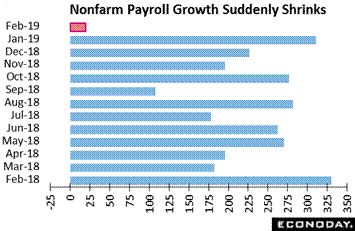 Averaging extremes is good advice to find an underlying path and February and January payrolls are the most recent example. Nonfarm payrolls rose by only 20,000 in February but follow a 311,000 surge in January with the average at a very healthy 166,000. Payrolls are part of the establishment survey of businesses while the unemployment rate is based on the household survey which includes those who are working but not on payrolls. Here February's story is much more positive showing a sharp rise in the number of those employed (up 255,000) and a sharp fall in the number of unemployed (down 300,000) that make for an unexpected 2 tenths dip in the unemployment rate to 3.8 percent. Averaging extremes is good advice to find an underlying path and February and January payrolls are the most recent example. Nonfarm payrolls rose by only 20,000 in February but follow a 311,000 surge in January with the average at a very healthy 166,000. Payrolls are part of the establishment survey of businesses while the unemployment rate is based on the household survey which includes those who are working but not on payrolls. Here February's story is much more positive showing a sharp rise in the number of those employed (up 255,000) and a sharp fall in the number of unemployed (down 300,000) that make for an unexpected 2 tenths dip in the unemployment rate to 3.8 percent.
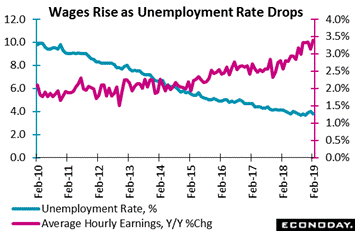 The steady decline of the unemployment rate over the last several years through the 5 percent level and then through 4 percent has been one of the most impressive runs of the nation's long economic record. The presumption of economic theory held of course that such a drop would trigger accelerating gains for wages that would risk a burst higher for general inflation. The latter has definitely not happened but to say that wages aren't accelerating isn't exactly accurate. Average hourly earnings, which are a key measure of wages, jumped an outsized 0.4 percent in February with the year-on-year rate moving to 3.4 percent for a new expansion high. Several years back as the unemployment rate was falling through key levels Federal Reserve officials were warning that hourly earnings were bound to rise and were projecting that readings over 3 percent would begin to lift overall prices. The Fed hasn't been saying this lately but extending wage gains, which really would be no surprise given the number of job openings and lack of people to fill them, could begin to shift Fedspeak from underscoring the positives of wage growth to warning of its excesses. And much like the Beige Book's tepid assessment of the labor market proved accurate, its assessment of wages also proved accurate, that wages are increasing across all skill levels, not just the highly skilled any more. In any case, both the unemployment rate and average hourly earnings were strong offsets to the headline collapse in payroll. growth. The steady decline of the unemployment rate over the last several years through the 5 percent level and then through 4 percent has been one of the most impressive runs of the nation's long economic record. The presumption of economic theory held of course that such a drop would trigger accelerating gains for wages that would risk a burst higher for general inflation. The latter has definitely not happened but to say that wages aren't accelerating isn't exactly accurate. Average hourly earnings, which are a key measure of wages, jumped an outsized 0.4 percent in February with the year-on-year rate moving to 3.4 percent for a new expansion high. Several years back as the unemployment rate was falling through key levels Federal Reserve officials were warning that hourly earnings were bound to rise and were projecting that readings over 3 percent would begin to lift overall prices. The Fed hasn't been saying this lately but extending wage gains, which really would be no surprise given the number of job openings and lack of people to fill them, could begin to shift Fedspeak from underscoring the positives of wage growth to warning of its excesses. And much like the Beige Book's tepid assessment of the labor market proved accurate, its assessment of wages also proved accurate, that wages are increasing across all skill levels, not just the highly skilled any more. In any case, both the unemployment rate and average hourly earnings were strong offsets to the headline collapse in payroll. growth.
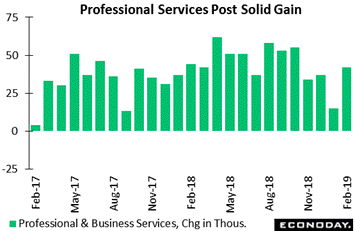 But payrolls were definitely weak in February with retail down 6,000 for its fourth decline in six months and with construction, where growth had been accelerating, down 31,000 in the month. Mining payrolls, which like construction had been an area of strength, fell 3,000 while government payrolls, an area of special focus following the federal shutdown, fell 5,000. But one positive sign of labor market demand came from professional & business services where payrolls jumped 42,000 and included a 6,000 rise for temporary workers. Gains here suggest that employers, who have been scrambling to build up their staffs and keep their businesses expanding, continue to rely on contractors to fill the gaps. But payrolls were definitely weak in February with retail down 6,000 for its fourth decline in six months and with construction, where growth had been accelerating, down 31,000 in the month. Mining payrolls, which like construction had been an area of strength, fell 3,000 while government payrolls, an area of special focus following the federal shutdown, fell 5,000. But one positive sign of labor market demand came from professional & business services where payrolls jumped 42,000 and included a 6,000 rise for temporary workers. Gains here suggest that employers, who have been scrambling to build up their staffs and keep their businesses expanding, continue to rely on contractors to fill the gaps.
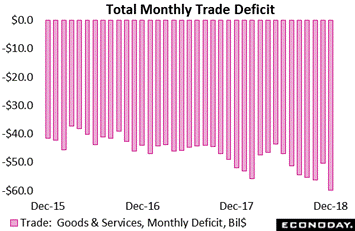 If payroll growth resumes its trend back to the 200,000 line it would really be no surprise at all. Less certain to show improvement, however, may be the nation's trade situation which deteriorated through most of last year. December's deficit of $59.8 billion was unexpectedly deep, actually the worst monthly showing since the recession of 2008. It was also the sixth deepening in the last seven months. The trouble was equally severe on both sides of the report as exports in December fell 2.8 percent to $205.1 billion while imports rose 2.4 percent to $264.9 billion. Correcting the nation's goods deficit has been a special focus of the Trump administration of course but so far, with Chinese negotiations still unfolding, improvement is hard to find. Goods exports fell 2.8 percent to $135.6 billion in December with goods imports rising 2.4 percent to $217.2 billion. Exports of services failed to help out December, unchanged at a still very strong $69.5 billion with imports of services, however, rising 1.0 percent to $47.7 billion. If payroll growth resumes its trend back to the 200,000 line it would really be no surprise at all. Less certain to show improvement, however, may be the nation's trade situation which deteriorated through most of last year. December's deficit of $59.8 billion was unexpectedly deep, actually the worst monthly showing since the recession of 2008. It was also the sixth deepening in the last seven months. The trouble was equally severe on both sides of the report as exports in December fell 2.8 percent to $205.1 billion while imports rose 2.4 percent to $264.9 billion. Correcting the nation's goods deficit has been a special focus of the Trump administration of course but so far, with Chinese negotiations still unfolding, improvement is hard to find. Goods exports fell 2.8 percent to $135.6 billion in December with goods imports rising 2.4 percent to $217.2 billion. Exports of services failed to help out December, unchanged at a still very strong $69.5 billion with imports of services, however, rising 1.0 percent to $47.7 billion.
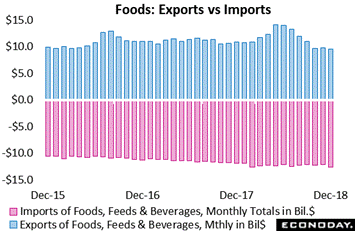 Food, a special focus surrounding U.S.-China trade talks, was a standout negative in the December trade report with imports at a monthly record $12.6 billion and exports, at $9.6 billion, posting their lowest monthly total since August 2010. This is more bad news for the nation's farmers where conditions, according to the latest Beige Book, remain "weak" with prices for soybeans and dairy products "notably weak". Vehicles were an even greater weakness in the trade report with monthly exports at $12.3 billion for a second month and the lowest since September 2017 while imports, at $32.1 billion, rose to a record high. Vehicles alone, another focus of the trade talks, represented 1/3 of December's deficit. Food, a special focus surrounding U.S.-China trade talks, was a standout negative in the December trade report with imports at a monthly record $12.6 billion and exports, at $9.6 billion, posting their lowest monthly total since August 2010. This is more bad news for the nation's farmers where conditions, according to the latest Beige Book, remain "weak" with prices for soybeans and dairy products "notably weak". Vehicles were an even greater weakness in the trade report with monthly exports at $12.3 billion for a second month and the lowest since September 2017 while imports, at $32.1 billion, rose to a record high. Vehicles alone, another focus of the trade talks, represented 1/3 of December's deficit.
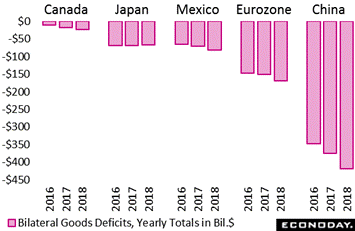 According to news reports, China has offered to increase purchases of U.S. agricultural products by $30 billion a year as part of a trade deal. But this would only put a small dent in the bilateral deficit which for full year 2018 came in at just over $419 billion. This is 12 percent deeper than $375 billion in 2017 and 21 percent deeper and $347 billion in 2016. Except for Japan, the deficits with other major trading partners are also deepening, coming in at a 2018 total of $169 billion with the Eurozone, $82 billion with Mexico, and more than $23 billion with Canada. Looking at the total picture, the nation's trade gap in 2018 came to $621 billion, 12.4 percent deeper than $552 billion in 2017 and the worst showing since the recession of 2008. According to news reports, China has offered to increase purchases of U.S. agricultural products by $30 billion a year as part of a trade deal. But this would only put a small dent in the bilateral deficit which for full year 2018 came in at just over $419 billion. This is 12 percent deeper than $375 billion in 2017 and 21 percent deeper and $347 billion in 2016. Except for Japan, the deficits with other major trading partners are also deepening, coming in at a 2018 total of $169 billion with the Eurozone, $82 billion with Mexico, and more than $23 billion with Canada. Looking at the total picture, the nation's trade gap in 2018 came to $621 billion, 12.4 percent deeper than $552 billion in 2017 and the worst showing since the recession of 2008.
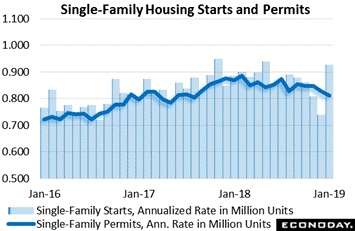 The week was not barren of good news, however. Single-family housing starts surged in January to a 926,000 annual rate for a 25 percent increase from December which was held down by wildfires in California. Starts in the West reversed December's drop while starts rose sharply in the South which is the largest housing region. Single-family construction is a major component for residential investment which contracted without interruption through each quarter last year. Though January's gain marks a positive start to the first quarter how far it will extend is in question given a slump underway in single-family permits. These fell 2.1 percent in the month to an 812,000 rate, their worst showing since August 2017. But maybe permits will pick up if sales of new single-family homes finally begin to pick up, and they certainly did in December rising 3.7 percent to a 621,000 annual rate though sharp downward revisions to November and October took some of the shine off the headline gain. And a clear reminder of how soft the housing market is, December's year-on-year rate for new home sales, despite the monthly jump, was still in the negative column at minus 2.4 percent. The week was not barren of good news, however. Single-family housing starts surged in January to a 926,000 annual rate for a 25 percent increase from December which was held down by wildfires in California. Starts in the West reversed December's drop while starts rose sharply in the South which is the largest housing region. Single-family construction is a major component for residential investment which contracted without interruption through each quarter last year. Though January's gain marks a positive start to the first quarter how far it will extend is in question given a slump underway in single-family permits. These fell 2.1 percent in the month to an 812,000 rate, their worst showing since August 2017. But maybe permits will pick up if sales of new single-family homes finally begin to pick up, and they certainly did in December rising 3.7 percent to a 621,000 annual rate though sharp downward revisions to November and October took some of the shine off the headline gain. And a clear reminder of how soft the housing market is, December's year-on-year rate for new home sales, despite the monthly jump, was still in the negative column at minus 2.4 percent.
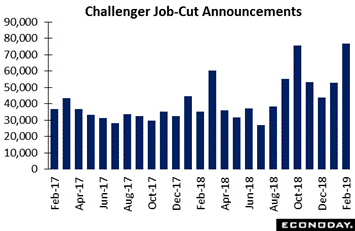 We end our data rundown with an ominously fitting conclusion for a disappointing week. Layoff announcements as tracked by the Challenger job-cut report have clearly shifted higher, beginning toward the end of last year and now into this year. Challenger's count for February was a 3-1/2 year high, at 76,835 vs 52,988 in January. The monthly average so far in the first quarter is 64,912 vs 57,534 in the fourth quarter and 40,293 and 34,933 in the third and second quarters. Industrial goods are not a favorable industry to have the highest concentration of layoff announcements which is the case for February, at 29,665 followed by retail at 18,874 and 22,327 the last two months and reflecting general restructuring in this sector. The increase in layoff announcements, implying a decrease in labor demand, had yet, at least perhaps until February jobs report, to be reflected in payroll growth or significantly reflected in actual jobless claims which have moved only slightly higher from historic lows. But actual layoffs following announcements are not always immediate, rather they can take months to conclude which, given the rise underway, may make disappointing employment reports less and less rare. We end our data rundown with an ominously fitting conclusion for a disappointing week. Layoff announcements as tracked by the Challenger job-cut report have clearly shifted higher, beginning toward the end of last year and now into this year. Challenger's count for February was a 3-1/2 year high, at 76,835 vs 52,988 in January. The monthly average so far in the first quarter is 64,912 vs 57,534 in the fourth quarter and 40,293 and 34,933 in the third and second quarters. Industrial goods are not a favorable industry to have the highest concentration of layoff announcements which is the case for February, at 29,665 followed by retail at 18,874 and 22,327 the last two months and reflecting general restructuring in this sector. The increase in layoff announcements, implying a decrease in labor demand, had yet, at least perhaps until February jobs report, to be reflected in payroll growth or significantly reflected in actual jobless claims which have moved only slightly higher from historic lows. But actual layoffs following announcements are not always immediate, rather they can take months to conclude which, given the rise underway, may make disappointing employment reports less and less rare.
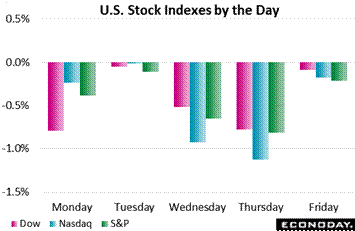 Against a general backdrop of easing data investors have been pulling back from risk and moving more into safer though lower yielding assets. This has been a trend going back to December for clients at TD Ameritrade and has been holding back the firm's investor momentum index. Yet to take hold is a structural offset for the markets, that the Federal Reserve will increasingly want to stimulate the economy as the economy slows. The Fed did shift guidance away from further rate hikes in January and has been repeating that it intends to wind down quantitative tightening sooner than later. Should the Fed sound even more increasingly dovish, as other central banks are sounding most notably the ECB, slumping economic data could have an increasingly limited effect on the markets. Against a general backdrop of easing data investors have been pulling back from risk and moving more into safer though lower yielding assets. This has been a trend going back to December for clients at TD Ameritrade and has been holding back the firm's investor momentum index. Yet to take hold is a structural offset for the markets, that the Federal Reserve will increasingly want to stimulate the economy as the economy slows. The Fed did shift guidance away from further rate hikes in January and has been repeating that it intends to wind down quantitative tightening sooner than later. Should the Fed sound even more increasingly dovish, as other central banks are sounding most notably the ECB, slumping economic data could have an increasingly limited effect on the markets.
Stocks fell all week long, losing 2.2 percent on the Dow to 25,450 with the Nasdaq off 2.5 percent at 7,408. The move into the safety of Treasuries was tangible with the 2-year yield down 10 basis points to 2.46 percent and the 10-year down 12 points at 2.63 percent. Both of these yields are now lower on the year. The dollar typically weakens when yields go down but not this time as the euro fell 1.2 percent in a week when the ECB promised to keep policy loose through year end. The dollar index posted a sharp weekly gain of 0.9 percent to 97.37 and now stands 1.3 percent higher on the year.
| Markets at a Glance |
Year-End |
Week Ended |
Week Ended |
Year-To-Date |
Weekly |
|
2018 |
1-Mar-19 |
8-Mar-19 |
Change |
Change |
| DJIA |
23,327.46 |
26,026.32 |
25,450.24 |
9.1% |
-2.2% |
| S&P 500 |
2,506.85 |
2,803.69 |
2,743.07 |
9.4% |
-2.2% |
| Nasdaq Composite |
6,635.28 |
7,595.35 |
7,408.14 |
11.6% |
-2.5% |
|
|
|
|
|
|
| Crude Oil, WTI ($/barrel) |
$45.84 |
$55.75 |
$56.04 |
22.3% |
0.5% |
| Gold (COMEX) ($/ounce) |
$1,284.70 |
$1,292.70 |
$1,299.80 |
1.2% |
0.5% |
|
|
|
|
|
|
| Fed Funds Target |
2.25 to 2.50% |
2.25 to 2.50% |
2.25 to 2.50% |
0 bp |
0 bp |
| 2-Year Treasury Yield |
2.50% |
2.56% |
2.46% |
−4 bp |
−10 bp |
| 10-Year Treasury Yield |
2.68% |
2.75% |
2.63% |
−5 bp |
−12 bp |
| Dollar Index |
96.11 |
96.46 |
97.37 |
1.3% |
0.9% |
Slowing has been the economic theme so far in 2019, whether in the U.S. or globally. Deterioration in cross-border trade is an immediate risk for the U.S. especially for the factory sector where swings up or down are considered directional indications for the economy as a whole. But domestic consumption has been mostly solid and, apart from December's plunge in retail sales, isn't showing too many cracks. February payrolls aside, U.S. output is growing at a healthy rate, wages are showing improvement, and the Federal Reserve looks less and less like it will stand in the way.
It's taken a while but data backup from the government shutdown is going to unroll in force in the coming week. Retail sales, which plummeted so sharply in December, will update the consumer and open the week on Monday and are expected to show weakness in the headline but strength underneath. Updating the factory sector, which has been sputtering itself, will be durable goods orders, also for January and expected to also be weak. Other delayed data will be January construction spending on Wednesday, where forecasters see only a modest bounce back from a weak December, and January new home sales on Thursday where no bounce at all is expected. Judging by the forecasters, neither the consumer sector nor the factory sector nor the housing sector are expected to show much strength at all in the week. A full slate of inflation data, none of which have been delayed, will be woven in between and the consensus estimates for all are moderate. And expectations for new home sales on Thursday and industrial production on Friday are also moderate. If the week's numbers come in as expected, pressure could build on the Federal Reserve to pull forward the end of quantitative tightening.
Retail Sales for January
Consensus Forecast: 0.0%
Consensus Range: -0.4% to 0.5%
Retail Sales Ex-Autos
Consensus Forecast: 0.2%
Consensus Range: 0.0% to 0.9%
Retail Sales Ex-Autos Ex-Gas
Consensus Forecast: 0.5%
Consensus Range: 0.2% to 1.2%
Retail Sales Control Group (Ex-Food Services, Ex-Autos, Ex-Gas, Ex-Building Materials)
Consensus Forecast: 0.7%
Consensus Range: 0.2% to 0.7%
Limited snap-back strength is the call for retail sales in January after dropping a sharp and very unexpected 1.2 percent in December. Unit vehicle sales were very weak in January which should give a relative boost to January's ex-auto sales which are expected at plus 0.2 after a plunge of 1.8 percent in December. Gas prices were weak and when excluding both gasoline and autos a solid 0.5 percent is expected with the control group seen at a strong 0.7 percent.
Business Inventories for December
Consensus Forecast, Month-to-Month Change: 0.6%
Consensus Range: 0.0% to 0.8%
A sharp looking 0.6 percent increase is the consensus for December business inventories vs a 0.1 percent contraction in November.
Small Business Optimism Index for February
Consensus Forecast: 102.8
Consensus Range: 102.0 to 103.8
After falling more than 3 points to its lowest level in more than two years, the small business optimism index is expected to bounce back to 102.8 in February vs 101.2 in January. February saw a sharp drop in the economic outlook and negative sentiment on both inventory and employment growth.
Consumer Price Index for February
Consensus Forecast, Month-to-Month Change: 0.2%
Consensus Range: 0.0% to 0.7%
Consumer Price Index
Consensus Forecast, Year-on-Year Change: 1.6%
Consensus Range: 1.4% to 1.8%
CPI Core, Less Food & Energy
Consensus Forecast, Month-to-Month Change: 0.2%
Consensus Range: 0.2% to 0.3%
CPI Core, Less Food & Energy
Consensus Forecast, Year-on-Year Change: 2.2%
Consensus Range: 2.2% to 2.4%
Moderate pressure is the call for the consumer price index, at a consensus increase of 0.2 percent following no change in each of the last three reports. The consensus for the ex-food ex-energy core rate is a fourth straight increase of 0.2 percent. Year-on-year rates for February are seen at 1.6 percent overall and 2.2 percent for the core vs January's respective rates of 1.6 percent and 2.2 percent.
Durable Goods Orders for January
Consensus Forecast, Month-to-Month Change: -0.8%
Consensus Range: -3.0% to 1.8%
Durable Goods Orders, Ex-Transportation
Consensus Forecast: 0.1%
Consensus Range: -0.1% to 0.3%
Core Capital Goods Orders (Nondefense Ex-Aircraft)
Consensus Forecast: 0.1%
Consensus Range: -0.1% to 0.1%
A second month of weakness for core capital goods was the unwanted feature of the December durable goods report and only a marginal bounce back of 0.1 percent is the consensus for core capital goods orders in January. Headline durable goods are expected to fall 0.8 percent in January vs December's 1.2 percent aircraft-boosted gain with ex-transportation orders seen at only a 0.1 percent increase.
PPI-FD for February
Consensus Forecast, Month-to-Month Change: 0.2%
Consensus Range: 0.0% to 0.3%
PPI-FD Less Food & Energy
Consensus Forecast, Month-to-Month Change: 0.2%
Consensus Range: 0.1% to 0.3%
PPI-FD Less Food, Energy, & Trade Services
Consensus Forecast, Month-to-Month Change: 0.2%
Consensus Range: 0.2% to 0.2%
Producer prices have been quiet and more of the same is the expectation for February, at a consensus increase of 0.2 percent vs a 0.1 percent decline in January. Less food & energy is also seen rising 0.2 percent vs January's 0.3 percent gain with the consensus for less food, energy and trade services at 0.2 percent as well.
Construction Spending for January
Consensus Forecast, Month-to-Month Change: 0.3%
Consensus Range: -0.4% to 1.0%
Extended contraction for single-family homes pulled construction spending down by 0.6 percent in December. Econoday's consensus for January is a modest 0.3 percent increase. Total year-on-year growth in December was a 3-year low at 1.6 percent.
Initial Jobless Claims for March 9 week
Consensus Forecast: 225,000
Consensus Range: 217,000 to 225,000
Following the government shutdown, initial jobless claims have now steadied at roughly the 220,000 to 225,000 level and are expected to come in at 225,000 in the March 9 week. Claims were at 223,000 in the March 2 week.
Import Prices for February
Consensus Forecast, Month-to-Month Change: 0.3%
Consensus Range: 0.3% to 0.8%
Export Prices
Consensus Forecast, Month-to-Month Change: 0.2%
Consensus Range: 0.0% to 0.5%
Forecasters see February import prices rising 0.3 percent after three straight months of contraction. Export prices, which have also fallen the last three reports and sharply so, are expected to rise only 0.2 percent.
New Home Sales for January
Consensus Forecast, Annualized Rate: 620,000
Consensus Range: 540,000 to 638,000
Often volatile, new home sales easily beat expectations in December at a 621,000 annual rate but prior months were revised lower and expectations for January are modest and call for little change, at a 620,000 rate.
Empire State Index for March
Consensus Forecast: 10.0
Consensus Range: 8.0 to 14.1
At a March consensus of 10.0 vs 8.8 in February, steady and solid growth is once again the expectation for the Empire State index. New orders rose solidly in February with the 6-month outlook showing special strength.
Industrial Production for February
Consensus Forecast, Month-to-Month Change: 0.4%
Consensus Range: 0.0% to 1.1%
Manufacturing Production
Consensus Forecast, Month-to-Month Change: 0.4%
Consensus Range: 0.1% to 0.5%
Capacity Utilization Rate
Consensus Forecast: 78.5%
Consensus Range: 78.3% to 79.0%
Reacceleration in manufacturing is expected to headline February industrial production which forecasters see coming in at a 0.4 percent gain following a 0.6 percent decline in January. Manufacturing production fell 0.9 percent in January and a 0.4 percent February gain is also the call. Capacity utilization is expected to tighten 3 tenths to 78.5 percent.
Consumer Sentiment Index, Preliminary March
Consensus Forecast: 94.8
Consensus Range: 94.0 to 96.7
Forecasters see a further bounce for consumer sentiment calling for a preliminary March reading of 94.8 that would compare with February's 93.8. This index was at 98.3 before the government shutdown and fell to 91.2 in January.
JOLTS: Job Openings for January
Consensus Forecast: 7.155 million
Consensus Range: 6.900 to 7.335 million
Forecasters see job openings easing to 7.155 million in January vs 7.335 million in December which was much higher than expected and included a large upward revision to November. Openings have been rising much faster than hires, at year-on-year rates of 29.4 percent and 7.1 percent in December's report.
|

